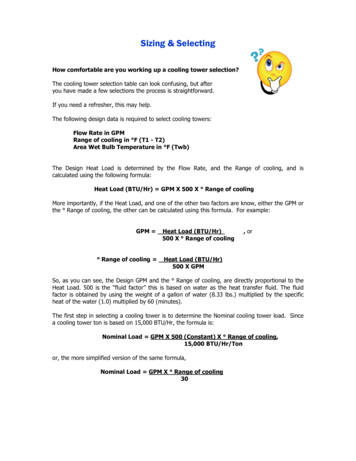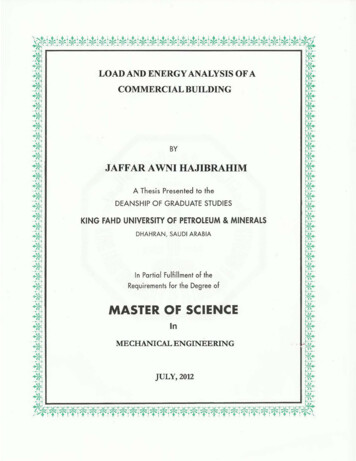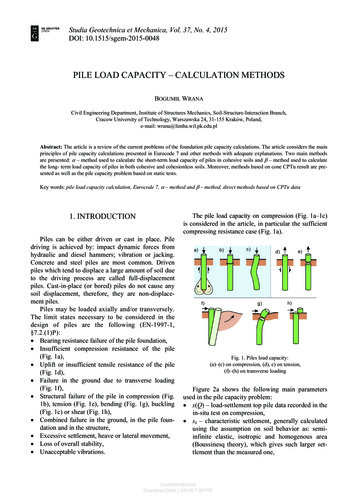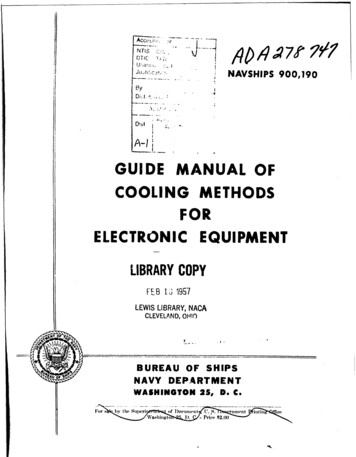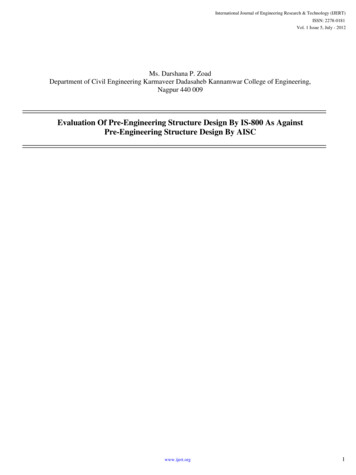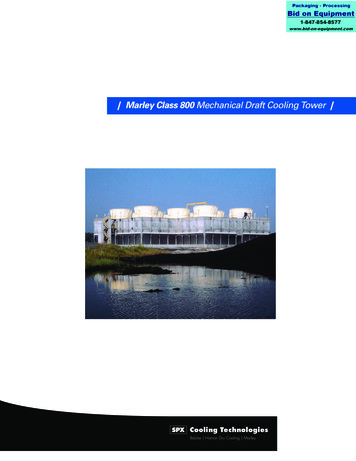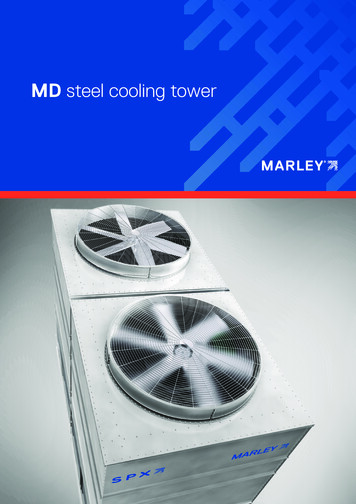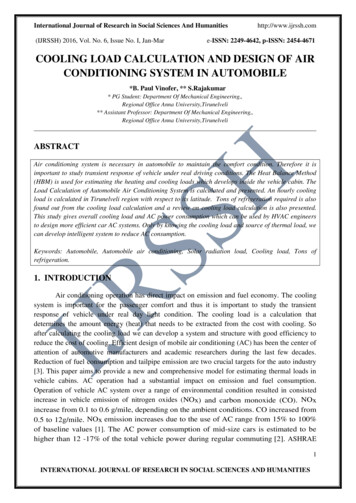
Transcription
International Journal of Research in Social Sciences And Humanities(IJRSSH) 2016, Vol. No. 6, Issue No. I, Jan-Marhttp://www.ijrssh.come-ISSN: 2249-4642, p-ISSN: 2454-4671COOLING LOAD CALCULATION AND DESIGN OF AIRCONDITIONING SYSTEM IN AUTOMOBILE*B. Paul Vinofer, ** S.Rajakumar* PG Student: Department Of Mechanical Engineering,,Regional Office Anna University,Tirunelveli** Assistant Professor: Department Of Mechanical Engineering,,Regional Office Anna University,TirunelveliABSTRACTAir conditioning system is necessary in automobile to maintain the comfort condition. Therefore it isimportant to study transient response of vehicle under real driving conditions. The Heat Balance Method(HBM) is used for estimating the heating and cooling loads which develops inside the vehicle cabin. TheLoad Calculation of Automobile Air Conditioning System is calculated and presented. An hourly coolingload is calculated in Tirunelveli region with respect to its latitude. Tons of refrigeration required is alsofound out from the cooling load calculation and a review on cooling load calculation is also presented.This study gives overall cooling load and AC power consumption which can be used by HVAC engineersto design more efficient car AC systems. Only by knowing the cooling load and source of thermal load, wecan develop intelligent system to reduce AC consumption.Keywords: Automobile, Automobile air conditioning, Solar radiation load, Cooling load, Tons ofrefrigeration.1. INTRODUCTIONAir conditioning operation has direct impact on emission and fuel economy. The coolingsystem is important for the passenger comfort and thus it is important to study the transientresponse of vehicle under real day light condition. The cooling load is a calculation thatdetermines the amount energy (heat) that needs to be extracted from the cost with cooling. Soafter calculating the cooling load we can develop a system and structure with good efficiency toreduce the cost of cooling. Efficient design of mobile air conditioning (AC) has been the center ofattention of automotive manufacturers and academic researchers during the last few decades.Reduction of fuel consumption and tailpipe emission are two crucial targets for the auto industry[3]. This paper aims to provide a new and comprehensive model for estimating thermal loads invehicle cabins. AC operation had a substantial impact on emission and fuel consumption.Operation of vehicle AC system over a range of environmental condition resulted in consistedincrease in vehicle emission of nitrogen oxides (NOx) and carbon monoxide (CO). NOxincrease from 0.1 to 0.6 g/mile, depending on the ambient conditions. CO increased from0.5 to 12g/mile. NOx emission increases due to the use of AC range from 15% to 100%of baseline values [1]. The AC power consumption of mid-size cars is estimated to behigher than 12 -17% of the total vehicle power during regular commuting [2]. ASHRAE1INTERNATIONAL JOURNAL OF RESEARCH IN SOCIAL SCIENCES AND HUMANITIES
International Journal of Research in Social Sciences And Humanities(IJRSSH) 2016, Vol. No. 6, Issue No. I, Jan-Marhttp://www.ijrssh.come-ISSN: 2249-4642, p-ISSN: 2454-4671Handbook of Fundamentals [4] provides two major thermal load calculation methodologies: HeatBalance Method (HBM) and Weighting Factor Method (WFM). HBM is the most scientificallyrigorous available method and can consider more details with less simplifying assumptions. Anadvantage of HBM is that several fundamental models can be incorporated in the thermalcalculations. Although HBM is more accurate than WFM, it is easier to implement WFM for loadcalculation in a passenger vehicle. However, when more detailed information of the vehicle bodyand thermal loads is available, HBM is the preferred choice [5]. Curtis O. Pedersen [6] paper haspresented a complete formulation of a heat balance procedure for determining cooling loads.From this paper how heat balance is formulated to calculate cooling load is studies. Zheng.Y[7] devised a simple method to calculate vehicle's thermal loads. They calculated the differentloads such as the radiation and ambient loads. A case study was performed and the results werevalidated using wind tunnel climate control tests. The different loads were separately calculatedand summed up to give the total heat gain or loss from the cabin. Ergonomics of the ThermalEnvironment - Determination of Metabolic Heat Production [8] provides passenger metabolicheat production rate based on various criteria such as occupation and activity levels. HuajunZhang [9] analyze the temperature and air-flow field inside the passenger compartment toameliorate the amenity and decrease energy consumption.This paper uses commercial software FLUENT to simulate 3-D temperature distributionsand flow field in a compartment with or without passengers. He suggested that the air flow andtemperature fields are definitely the most important factors that contribute to thermal comfort.Ozgur Solmaz [10] uses Artificial Neural Networks (ANNs) method for prediction hourly coolingload of a vehicle. He suggested that ANN method can be very effective as it is simpler and doesnot use so many input parameters like the analytical model. OumSaad Abdulsalam [11] calculatedheat occurred in the cabin consists of metabolic, direct, diffuse, reflected, ambient, exhaust,engine, ventilation, and AC loads. The cooling load transient analysis is performed usingMATLAB simulation tool. Md Shahid Imam [12] designed a air conditioning system for a Volvobus. He obtained the final output as 8.25 tons of refrigeration. Ashok Patidar [13] predicted thethermal comfort of the vehicle cabin using computational fluid dynamics. By CFD air flowanalysis he determines the soaking analysis gives a realistic distribution of temperature inside thecabin. Alex Alexandrov [14] uses two and three-dimensional computer simulations to addressissues of climate control and performance of Heating, Ventilation and Aero-Conditioning(HVAC) system of a generic passenger car. O. Kaynakli [15] investigate the effects of automobileinterior conditions resulted by heating and cooling process. The effects of interior environmentalconditions on the human physiology and comfort in heating and cooling processes are introduced.Wei and Dage [16] developed an intelligent cabin climate control system based on humansensory response to comfort factors. Vijayakumar Nachimuthu, Prabhu Mani, Muthukumar. P[17] studied the use of PCM to control the heat generated inside a car cabin due to solar radiationand with the help of CFD, a comparative analysis are executed. Khayyam [18] presents an energymanagement system to reduce the energy consumption of a vehicle when its Air conditioningsystem is in use. The system controls the mass flow rate of the air by dynamically adjusting theblower speed and air-gates opening under various heat and loads circumstances. Hamid Khayyam95INTERNATIONAL JOURNAL OF RESEARCH IN SOCIAL SCIENCES AND HUMANITIES
International Journal of Research in Social Sciences And Humanities(IJRSSH) 2016, Vol. No. 6, Issue No. I, Jan-Marhttp://www.ijrssh.come-ISSN: 2249-4642, p-ISSN: 2454-4671[19] uses thermal load combine with a fuzzy logic air conditioning enhanced look- ahead systemwhich estimated future road slope within a distance ahead of the vehicle. They showed that 12%energy consumption savings can be achieved using their proposed enhanced fuzzy system.2. METHODOLOGY AND LOAD CALCULATIONA lumped model of a vehicle cabin was considered for thermal load calculation. Severalloads act on the vehicle cabin and they are classified under nine different categories. Thesummation of all the load types will be the instantaneous cabin overall heat load gain. Themathematical formulation of the model can thus be summarized asFigure 1 schematically shows the various thermal load categories encountered in a typical vehiclecabin. Some of the above loads pass across the vehicle body plates/parts,while others areindependent of the surface.Figure 1: Various thermal loadMetabolic Load:This amount is considered as a heat gain by the cabin air and is called the metabolic load. Themetabolic load can be calculated bySOLAR RADIATION LOAD: Direct radiation is that part of the incident solar radiation whichdirectly strikes a surface of the vehicle body, which is calculated from96INTERNATIONAL JOURNAL OF RESEARCH IN SOCIAL SCIENCES AND HUMANITIES
International Journal of Research in Social Sciences And Humanities(IJRSSH) 2016, Vol. No. 6, Issue No. I, Jan-Marhttp://www.ijrssh.come-ISSN: 2249-4642, p-ISSN: 2454-4671Diffuse radiation is the part of solar radiation which results from indirect radiation of daylighton the surface. During a cloudy day, most of the solar radiation is received from this diffuseradiation. The diffuse radiation heat gain is found byReflected radiation refers to the part of radiation heat gain that is reflected from the ground andstrikes the body surfaces of the vehicle. The reflected radiation is calculated byAmbient Load: The increasing in the heat indicates that the weather data effect is very importantas the change in the ambient temperature affecting the calculation of the external and internalcooling loads.Exhaust Load: Vehicles have an internal combustion engine that creates exhaustgases. The high temperature of the exhaust gas can contribute to the thermal gain of thecabin through the cabin floor.ENGINE LOAD: Engine load calculation should be considered on severe operating conditionsof the engine installation such as high engine output, low vehicle speed, and/or hot ambienttemperatures. The heat transfer capacity of the radiator is dependent on the temperature ofambient air.97INTERNATIONAL JOURNAL OF RESEARCH IN SOCIAL SCIENCES AND HUMANITIES
International Journal of Research in Social Sciences And Humanities(IJRSSH) 2016, Vol. No. 6, Issue No. I, Jan-Marhttp://www.ijrssh.come-ISSN: 2249-4642, p-ISSN: 2454-4671Ventilation Load: It is not efficient to use hot ambient air for ventilation when cooling isrequired.AC Load: AC load is used to maintain the comfort in driving condition. Various thermal loadsestimations in vehicle cabins can be an assessment of the dynamic changes to the AC loads thatoccur in the severe condition3. CABIN GEOMENTRYIn order to perform the energy simulations of the present model, the geometry of the cabinshould be known. The simplified vehicle cabin is given belowFigure 2: Vehicle Cabin4. RESULTS AND DISCUSSIONThe vehicle is assumed to be driving approximately towards south. It’s assumed thatcooling load calculation is done in the month of May 15. Cooling load is estimated for thetransient period from 10.00 am to 4.00 pm. The cooling capacity needed to satisfy the coolingload in the tested vehicles cabin room under warm weather conditions which is not in the comfortlevel of 23 C. In this hot weather, a negative cabin load is provided to the cabin in order todecrease its temperature to the comfort level. The heat gain in the cabin due to metabolic load isconstant due to no change in the number of passengers. The direct and diffuse radiation loads are98INTERNATIONAL JOURNAL OF RESEARCH IN SOCIAL SCIENCES AND HUMANITIES
International Journal of Research in Social Sciences And Humanities(IJRSSH) 2016, Vol. No. 6, Issue No. I, Jan-Marhttp://www.ijrssh.come-ISSN: 2249-4642, p-ISSN: 2454-4671another positive load. The direct loads have a greater contribution than diffuse or reflected load.The direct and diffuse radiation load increases due to the increase in the sun altitude angle. Thetable below gives the overall load acting on the vehicle cabin.TimeQmetQ directQ .27Q refQ ambQ eshQ engQ venQ ACQ totalSince cooling is done, the load is negative.5. CONCLUSIONUsing heat balance method, the heat occurred in the cabin consists of metabolic, direct,diffuse, reflected, ambient, exhaust, engine, ventilation, and AC loads has been calculated. Acooling load of negative value of 2154.27W is estimated. To design AC refrigeration 0.76 tons ofrefrigeration is needed.REFERENCES[1]Welstand, J., Haskew, H., Gunst, R., and Bevilacqua, O., “Evaluation of the Effects of AirConditioning Operation and Associated Environmental Conditions on Vehicle Emissionsand Fuel Economy,” SAE Technical Paper 2003-01-2247, 2003, doi:10.4271/2003-012247.99INTERNATIONAL JOURNAL OF RESEARCH IN SOCIAL SCIENCES AND HUMANITIES
International Journal of Research in Social Sciences And Humanities(IJRSSH) 2016, Vol. No. 6, Issue No. I, Jan-Marhttp://www.ijrssh.come-ISSN: 2249-4642, p-ISSN: 2454-4671Lambert, M. A., and Jones, B. J., “Automotive Adsorption Air Conditioner Powered byExhaust Heat. Part 1: Conceptual and Embodiment Design,” Proceedings of theInstitution of Mechanical Engineers, Part D: Journal of Automobile Engineering,220(7):959-972, 2006, doi: 10.1243/09544070JAUTO221.[3] Fayazbakhsh A. M., and Bahrami M., “Comprehensive Modeling of Vehicle AirConditioning Loads Using Heat Balance Method”, Journal of SAE International, SimonFrazer University, 10.4271/2013-01-1507, 2013.[2][4]ASHRAE Handbook of Fundamental, American Society of Heating, Refrigerating, andAir Conditioning, Atlanta, GA, 1988.[5]Kamar, H., Senawi, M., and Kamsah, N., “Computerized Simulation of Automotive AirConditioning System: Development of Mathematical Model and Its Validation,” IJCSIssues, 9(2):23-34, 2012.Pedersen, C. O., Fisher, D. E., and Liesen, R. J., “Development of a Heat BalanceProcedure for Calculating Cooling Loads,” ASHRAE Transactions, 103(2):459-468,1997.[7] Zheng, Y., Mark, B., and Youmans, H., “A Simple Method to Calculate Vehicle HeatLoad,” SAE Technical Paper 2011-01-0127, 2011, doi:10.4271/2011-01-0127.[6]ISO Standard, “Ergonomics of the Thermal Environment- Determination of MetabolicHeat Production,” ISO Standard 8996, Rev. 2004.[9] Huajun Zhang, Lan Dai, Guoquan Xu, Yong Li, Wei Chen, Wen-Quan Tao.,” Studies ofair-flow and temperature fields inside a passenger compartment for improving thermalcomfort and saving energy. Part I: Test/numerical model and validation” Applied ThermalEngineering 29 (2009) 2022–2027.[10] Ozgur Solmaz, Muammer Ozgoren, Muharrem Hilmi Aksoy.,” Hourly cooling loadprediction of a vehicle in the southern region of Turkey by artificial neural network”Energy Conversion and Management 82 (2014) 177–187.[11] OumSaad Abdulsalam, Budi Santoso, Dwi Aries., “Cooling Load Calculation andThermal Modeling for Vehicle by MATLAB” IJIRSET Vol. 4, Issue 5, May 2015.[12] Md Shahid Imam, Dr.M.Shameer Basha, Dr.Md.Azizuddin, Dr. K.Vijaya Kumar Reddy.,“Design of Air Conditioning system in automobile” IJIRSET Vol. 2, Issue 12, December2013.[13] Patidar, A., "Simulation and Validation of Passenger Compartment Soaking andCooling under Solar Load," SAE Technical Paper 2009-28-0050, 2009,doi:10.4271/2009-28-0050.[8][14] Alexandrov,A., Kudriavtsev, V., and Reggio, M., “Analysis of Flow Patterns and HeatTransfer in Generic Passenger Car Mini-Environment,” Presented at 9th AnnualConference of the CFD Society of Canada, Canada, May 27-29, 2001.[15] O. Kaynakli, E. Pulat, M. Kilic.,” Thermal comfort during heating and cooling periods inan automobile” Heat Mass Transfer (2005) 41: 449–458 DOI 10.1007/s00231-004-05589.100INTERNATIONAL JOURNAL OF RESEARCH IN SOCIAL SCIENCES AND HUMANITIES
International Journal of Research in Social Sciences And Humanities(IJRSSH) 2016, Vol. No. 6, Issue No. I, Jan-Marhttp://www.ijrssh.come-ISSN: 2249-4642, p-ISSN: 2454-4671K. C., and Dage, G. A., “An Intelligent Automotive Climate Control System,” IEEEInternational Conference on Systems, Man and Cybernetics. Intelligent Systems for the21st Century, 4:2977-2982, 1995, doi: 10.1109/ICSMC. 1995.538237.[17] Vijayakumar Nachimuthu, Prabhu Mani, Muthukumar. P., “CFD Analysis of Applicationof Phase Change Material in Automotive Climate Control Systems” IJIRSET Volume 3,Special Issue 2, April 2014.[16] Wei,[18] Khayyam,H., Kouzani, A. Z., and Hu, E. J., “Reducing Energy Consumption of VehicleAir Conditioning System by an Energy Management System,” Presented in IEEE The 4thInternational Green Energy Conference, China, 2009.[19] Khayyam,H., Nahavandi, S., Hu, E., Kouzani, A., Chonka, A., Abawajy, J., Marano,V., and Davis, S., “Intelligent Energy Management Control of Vehicle AirConditioning via Look-Ahead System,” Applied Thermal Engineering, 31(16):31473160, 2011, doi: 10.1016/ j.applthermaleng.2011.05.023.[20] Solar energy- Principles of thermal collection and storage by SP.Sukhatme and JK.Nayak.[21] HANDBOOK ON ENERGY CONSCIOUS BUILDINGS Prepared under the interactiveR & D project no. 3/4(03)/99-SEC between Indian Institute of Technology, Bombay andSolar Energy Centre, Ministry of Non-conventional Energy Sources J.K. Nayak J.A.Prajapati May.101INTERNATIONAL JOURNAL OF RESEARCH IN SOCIAL SCIENCES AND HUMANITIES
International Journal of Research in Social Sciences And Humanities(IJRSSH) 2016, Vol. No. 6, Issue No. I, Jan-Marhttp://www.ijrssh.come-ISSN: 2249-4642, p-ISSN: 2454-4671NOMENCLATUREA- Apparent Solar Irradiation at Air2Mass 0 (W/ m2)ADu - DuBois Body SurfaceArea ( m )B- AtmosphericExtinction Coefficientc- Specific Heat (J/kg K)C- Diffuse Radiation FactorDTM - Deep ThermalMass (J/K)e- Enthalpy (J/kg)h- Convective Heat TransferCoefficient(W/m2K)Hİ- Human Body Height (m)- Radiation Heat Gain per UnitArea (W/m2)K- Conductive Heat TransferCoefficient (W/mK)M- Mass (kg)ṁ- Mass Flow Rate(kg/s)M- Metabolic Rate(W/m2)P(Pa)PsR- Air PressureGreek Lettersα - Absorptivityβ - Altitude Angle ( )Δt - Time Step Size ( s)ΔT - Temperature Change ( K)ϕ - Relative Humidity (%)λ - Surface Element Thickness (m)θ - Angle between Surface Normal and SunPosition ( )ρ - Density (kg/ m3)ρg - Ground ReflectivityΣ - Surface Tilt Angle from Horizon ( )τ- TransmissivitySubscriptsa- Cabin AirAC - Air ConditioningAmb - Ambientcomf ComfortDif- Diffuse Radiation- Water Saturation Pressure (Pa)- Surface Overall Heat TransferResistance (m2K/W)Dir - Direct RadiationRPM - Engine Revolutions perMinute (1/min) S- CabinSurface Element Area (m2)Exh - ExhaustTc - Pull-DownConstant (s)t- Pull-DownTime (s)oMet - MetabolicTEng - Enginei- InsideNew - New Time Stepo- Outsideold- Old Time Step- Temperature ( K)102INTERNATIONAL JOURNAL OF RESEARCH IN SOCIAL SCIENCES AND HUMANITIES
International Journal of Research in Social Sciences And Humanities(IJRSSH) 2016, Vol. No. 6, Issue No. I, Jan-MarT0- Initial Cabin Temperature ( K)http://www.ijrssh.come-ISSN: 2249-4642, p-ISSN: 2454-4671Rad - RadiationU- Surface Overall Heat TransferCoefficient ( W/ m2 K)V- Vehicle Speed (m/ s)W- Human Body Weight (kg )X- Humidity Ratio (kg water/kg dryair)103INTERNATIONAL JOURNAL OF RESEARCH IN SOCIAL SCIENCES AND HUMANITIES
found out from the cooling load calculation and a review on cooling load calculation is also presented. This study gives overall cooling load and AC power consumption which can be used by HVAC engineers to design more efficient car AC systems. Only by knowing the cooling load and source of thermal load, we
